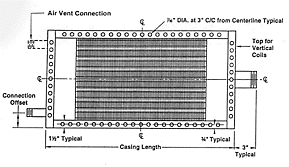 Air can be insidious and potentially dangerous to the proper operation of a steam heating system. However, in a properly designed system, air can be controlled and for the most part eliminated. Air in a system cannot be totally avoided. It is a natural byproduct of steam generation. It is present during equipment start-up and is often found in feedwater. Air and other non-condensable gases can serve as insulators between the steam and the coil surface, thereby decreasing efficiency. Worse, dissolved carbon dioxide and oxygen in condensate form a corrosive carbonic acid that can eat through pipes and tubes. Therefore, it is extremely important to remove both the air and the condensate from the steam heating system.
Air can be insidious and potentially dangerous to the proper operation of a steam heating system. However, in a properly designed system, air can be controlled and for the most part eliminated. Air in a system cannot be totally avoided. It is a natural byproduct of steam generation. It is present during equipment start-up and is often found in feedwater. Air and other non-condensable gases can serve as insulators between the steam and the coil surface, thereby decreasing efficiency. Worse, dissolved carbon dioxide and oxygen in condensate form a corrosive carbonic acid that can eat through pipes and tubes. Therefore, it is extremely important to remove both the air and the condensate from the steam heating system.
The best way to remove condensate is with a properly-applied steam trap. But that doesn’t always take care of air and other gasses. While the thermostatic air vents that are integral to float and thermostatic steam traps work well to remove air and other non-condensables, they are not always enough. It is always advisable to install auxiliary air vents with steam coils. The recommended location for an auxiliary air vent is on the condensate line at the top of a riser located 12 to 18 inches above the bottom of the coil, before the steam trap. In systems that operate at pressures lower than 15 psig the outlet of the air vent should be piped to the condensate return.
Further, all steam coils should have a vacuum breaker installed. Control valves, regulators, isolation valves, and the process of shutting the system down can induce situations wherein coils operate at sub-atmospheric pressures. In this condition coils are subject to collapse, in effect crumbling like a beer can given enough vacuum. To prevent coil collapse and keep condensate moving, vacuum breakers should be utilized. Vacuum breakers can be installed in the piping immediately before the coil or in the condensate line before the steam trap. Whenever steam supply pressure falls below atmospheric the vacuum breaker will open, inducing air into the system and breaking the vacuum. While this may seem counterintuitive, considering the dangers of air in the system, it is much more important to keep everything moving, avoid a potential coil collapse and or frozen coil, and deal with the air through venting.
It is always advisable to work with a steam specialist when installing or replacing steam coils, and when designing and troubleshooting steam systems. RJ Owen Associates has over 30 years mechanical and technical experience and can help with industrial heating ventilation, and process control applications. Contact us for more info.
